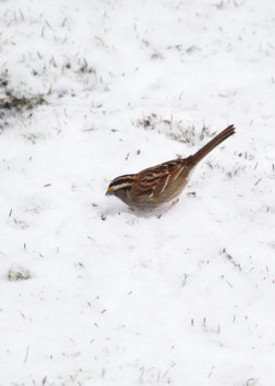 One day, we will awaken and the snow will finally be off the lawn and the terrace. It seems to have been, the longest, coldest, white winter in memory, but spring will come. (Mother Nature, are you listening?)
One day, we will awaken and the snow will finally be off the lawn and the terrace. It seems to have been, the longest, coldest, white winter in memory, but spring will come. (Mother Nature, are you listening?)
I have read that we have a new weather pattern, the polar vortex. Winter was colder than normal and we had snow pack most of the time. The spring forecast is for cold, then much warmer in April and May with average rainfall. I guess the woodchuck’s February prediction got it right.
Here are 5 things one can do while waiting for slow old Ma Nature to hear us:
1. The good thing is that the perennials were all protected with their blanket of white stuff and won’t have much winterkill. The bad thing is that the temperature fluctuations, bitter cold, then warmth, then cold, will produce lots of winter burn on the exposed parts of plants and trees.
2. About winter burn. Leaves turn brown or black and die, particularly rhododendrons and other evergreens. What to do? Just wait and see how things evolve. Don’t jump the gun with pruning until the plants have a chance to decide what’s been burned. When plants are under stress, and when the winter has been longer than usual, they will be slow to leaf out and to brown.
As the temperatures warm, the buds will swell as usual and begin to open. Some will succeed, others will shrivel up and die. Again, be patient before pruning what looks sickly until late April and into May. However now, one can tidy up winter damage, and also prune for shape and size.
3. The lawn has been protected under the snow all winter, and, unfortunately so has the mold fungi that attacks it later in the season. It is recommended that the first mowing’s grass clippings should be caught and thrown out to remove some of the fungus. However, don’t rake your lawn in spring when the new roots are just beginning to grow.
4. What most people don’t know is that this is a good time to add grass seed over thin, bare spots, especially on top of the melting snow. The seeds get pulled into the soil, watered, and are all ready when it warms up. And they compete for space with the crabgrass seeds which are already there, and just waiting to sprout when the forsythia blooms.
5. About grass seed. Most mixes are rye, fescue and blue grass. Perennial rye germinates fastest, (never use annual rye). Read the box label for sun, shade, heavy use, etc., then sprinkle on the melting snow. Sprinkling a little seed makes one feel that spring is really coming.
Ruth S. Foster is a Landscape Designer and Arborist. More info can be found on her web site: mothersgarden.net.
Credit: www.mothersgarden.net




























